Contents
What is a bone spur
Osteophytes are bone spurs or bony lumps that grow on the bones of the spine or around the joints.
Most bone spurs cause no symptoms and may go undetected for years. They may not require treatment. Decisions about treatment depend on where spurs are situated and how they affect your health.
The main cause of bone spurs is the joint damage associated with osteoarthritis, a condition that causes joints to become painful and stiff.
Bone spurs (osteophytes) can grow from any bone, but they’re most often found in the:
- neck
- shoulder
- knee
- lower back
- fingers or big toe
- foot or heel
Figure 1. Bone spur ankle
Figure 2. Bone spur shoulder
Bone spur (osteophyte) symptoms
Most bone spurs (osteophytes) don’t cause symptoms. You might not realize you have bone spurs until an X-ray for another condition reveals the growths. In some cases, though, bone spurs can cause pain and loss of motion in your joints.
They can cause problems if they:
- rub against other bone or tissue
- restrict movement
- squeeze nearby nerves
Figure 3. Bone spur neck
For example, osteophytes that occur in the:
- Bone spur spine. Bone spurs on your vertebrae can narrow the space that contains your spinal cord. These bone spurs can pinch the spinal cord or its nerve roots and can cause weakness or numbness in your arms or legs. Spine bone spur can cause pain and stiffness in the back
- Bone spur neck can pinch a nearby nerve and cause pain, pins and needles, numbness or weakness in the arms
- Bone spur hip: Bone spurs can make it painful to move your hip, although you might feel the pain in your knee. Depending on their placement, bone spurs can reduce the range of motion in your hip joint.
- Bone spur shoulder can limit the space available for tendons and ligaments, and may be linked to tendonitis or a rotator cuff tear
- Bone spur hip and knee can reduce the range of movement and are often associated with painful arthritis
- Bone spur knee: Bone spurs in your knee may make it painful to extend and bend your leg. The bony growths can get in the way of bones and tendons that keep your knee operating smoothly.
- Bone spur fingers can cause lumps and make the joints in your fingers look knobby.
Figure 4. Bone spur fingers
Figure 5. Bone spur knee
What causes bone spur (osteophyte)?
Osteophytes tend to form when the joints have been affected by arthritis.
Osteoarthritis damages cartilage, which is the tough, white, flexible tissue that lines the bones and allows the joints to move easily.
Osteoarthritis mostly occurs in the knees, hips, spine and small joints of the hands and base of the big toe.
As the joints become increasingly damaged, new bone may form around the joints. These bony growths are called osteophytes.
Osteophytes can also form in the spine as a result of ankylosing spondylitis, a type of arthritis that specifically affects the spine.
Bone spur (osteophyte) Diagnosis
During the physical exam, your doctor may feel around your joint to pinpoint your pain. Sometimes your doctor can feel a bone spur.
Your doctor may order X-rays or other imaging tests to view your joints and bones.
Bone spur (osteophyte) treatment
Osteophytes don’t usually cause pain, but the associated arthritis might.
If your bone spurs cause pain, your doctor may recommend over-the-counter pain relievers, such as acetaminophen (Tylenol, others), ibuprofen (Advil, Motrin IB, others) or naproxen sodium (Aleve, others), may help. Ibuprofen is a non-steroidal anti-inflammatory drug (NSAID), which can also help reduce any swelling and inflammation.
If you’re overweight, losing weight will help by relieving some of the strain on your joints.
A physiotherapist may also be able to help you by recommending exercises that can strengthen the muscles surrounding the problem area, and by helping to improve your range of movement.
Surgery can sometimes be used to help manage any underlying arthritis in the joint. It can be helpful for osteoarthritis that affects your hips, knees or joints, particularly those at the base of your thumb.
There’s usually no need to remove a bone spur (osteophyte), unless it’s irritating a nerve in the spine or restricting a joint’s range of movement.
If you do need surgery to remove an osteophyte, your surgeon will explain the procedure’s risks and benefits.
Bone spur heel
A heel spur is a bony growth under the heel bone, visible on X-ray only. If you feel pain in your heel when you get out of bed in the morning and take your first few steps for the day, you could have a heel spur.
One out of 10 people has heel spurs, but only 1 out of 20 people (5%) with heel spurs has foot pain. The pain can be treated without removing the spur.
Figure 6. Heel spur
What causes a heel spur?
Heel spurs are often caused by a combination of factors, including:
- problems with how the feet function (biomechanics)
- running on hard surfaces
- unsupportive footwear
- being overweight or obese.
All of these things can cause strain on the heel bone, ligaments, plantar fascia and muscles of the foot. The plantar fascia tightens and starts tugging on the heel bone, causing the spur to form.
Heel spur prevention
To prevent heel spurs, wear appropriate footwear, manage your weight, avoid exercising on hard surfaces and keep feet and leg muscles and joints flexible.
Heel spur symptoms
Heel spurs cause intermittent or chronic pain when inflammation builds up where the spur connects to the soft tissues of your foot. You may feel pain when walking or running, especially on hard surfaces.
Heel pain is usually caused by injury and inflammation to soft tissues, for example plantar fasciitis, and not by the heel spur itself.
You may feel a sharp pain when pressure is applied in the area, such as when you stand up or when getting out of bed in the morning. After a while, the pain may become a dull ache.
Heel spur diagnosis
A heel spur can be diagnosed using an X-ray.
Heel spur treatment
Treatment for heel spurs may incorporate a range of options:
- footwear needs to fit, provide adequate support for the types of activity you do, and not cause you any pain
- strapping/Taping to support the foot, taking the strain away from the foot muscles and plantar fascia, which allows the area to heal
- stretching exercises for the plantar fascia and calf muscles
- orthotics for your shoes that support, align and improve how your foot functions
- medication such as anti-inflammatories to reduce pain and inflammation in the area
- surgery is only considered after all other treatments fail. Surgery may involve removing the spur from the bone, though it can also involve releasing the plantar fascia.
It usually takes about 6 to 8 weeks to recover from a heel spur, when the area is strapped and rested.










